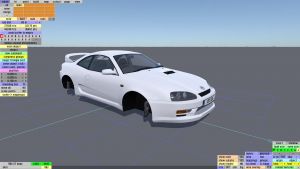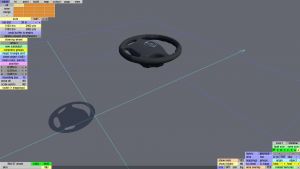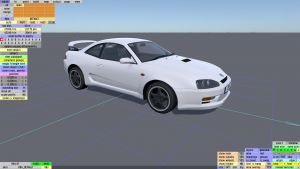Difference between revisions of "LFS Editor/Guides/Loading & Saving a Model in Modeller"
m |
m |
||
| (8 intermediate revisions by the same user not shown) | |||
| Line 1: | Line 1: | ||
| + | {{Infobox LFS Editor}} | ||
| + | |||
You can load either an existing object made in the [[LFS Editor]], or an external model in OBJ format. | You can load either an existing object made in the [[LFS Editor]], or an external model in OBJ format. | ||
| Line 15: | Line 17: | ||
[[image:RB4 modeller standalone.jpg|thumb|RB4 GT loaded in modeller using the 'LOAD' function. Notice the absence of wheels because the object was not loaded through [[Vehicle Editor]].]] | [[image:RB4 modeller standalone.jpg|thumb|RB4 GT loaded in modeller using the 'LOAD' function. Notice the absence of wheels because the object was not loaded through [[Vehicle Editor]].]] | ||
[[image:Modeller subobject.jpg|thumb|The RB4 GT steering wheel loaded in [[Modeller]]]] | [[image:Modeller subobject.jpg|thumb|The RB4 GT steering wheel loaded in [[Modeller]]]] | ||
| − | |||
| − | + | {{steps | |
| − | + | | Open the [[Vehicle Editor]]. | |
| − | + | | In the bottom left corner of the screen, click the {{old button|LOAD|#00ff00}} button. | |
| + | | Select a vehicle from the list in the dialog and click {{button|OK}}. | ||
| + | | Press {{key press|Esc}} or click {{old button|E - Edit Model|#a1a1ff}} in the bottom right part of the screen. | ||
| + | }} | ||
To go back from the [[Modeller]] to the [[Vehicle Editor]], press {{key press|Esc}} - the changes done in the modeller will be carried over automatically, there is no need to save it explicitly. | To go back from the [[Modeller]] to the [[Vehicle Editor]], press {{key press|Esc}} - the changes done in the modeller will be carried over automatically, there is no need to save it explicitly. | ||
| − | === Loading | + | === Loading a standalone object saved from LFS editor === |
| − | + | {{steps | |
| − | + | | Enter the [[Modeller]] in a standalone mode from the LFS editor entry screen. | |
| − | + | | At the bottom left of the screen, click the {{old button|LOAD|#00ff00}} button. | |
| − | + | | Select an object from the list in the dialog and click {{button|OK}}. | |
| + | }} | ||
Such object can be the main object (car body) or a subobject, like a steering wheel. | Such object can be the main object (car body) or a subobject, like a steering wheel. | ||
| − | |||
| − | |||
| − | |||
| − | |||
| − | |||
| − | |||
| − | |||
| − | |||
| − | |||
| − | |||
| − | |||
| − | |||
| − | |||
| − | |||
| − | |||
| − | |||
| − | |||
| − | |||
| − | |||
| − | |||
| − | |||
| − | |||
| − | |||
| − | |||
| − | |||
| − | |||
| − | |||
| − | |||
| − | |||
| − | |||
| − | |||
| − | |||
| − | |||
| − | |||
| − | |||
| − | |||
| − | |||
| − | |||
| − | |||
| − | |||
| − | |||
| − | |||
| − | |||
| − | |||
| − | |||
| − | |||
== Saving a model == | == Saving a model == | ||
| Line 88: | Line 47: | ||
=== Saving a standalone object === | === Saving a standalone object === | ||
| − | To save a model as a standalone object, click the {{old button|SAVE|#00ff00}} button at the bottom left of the screen. The object will be saved into the | + | To save a model as a standalone object, click the {{old button|SAVE|#00ff00}} button at the bottom left of the screen. The object will be saved into the {{folder|data|3dob}} folder, which can be loaded again through the modeller or [[Vehicle Editor]]. |
=== Saving a vehicle model === | === Saving a vehicle model === | ||
If you have entered the [[Modeller]] through the [[Vehicle Editor]], there is no need to save the vehicle model explicitly. You can go back to the [[Vehicle Editor]] by pressing the {{key press|Esc}} key. | If you have entered the [[Modeller]] through the [[Vehicle Editor]], there is no need to save the vehicle model explicitly. You can go back to the [[Vehicle Editor]] by pressing the {{key press|Esc}} key. | ||
| + | |||
| + | [[Category:LFS Editor Guides|{{SUBPAGENAME}}]] | ||
Latest revision as of 22:33, 7 February 2024
| LFS Editor | |
|---|---|
|
|
| Vehicle Mods |
You can load either an existing object made in the LFS Editor, or an external model in OBJ format.
The button for loading a model is located in the bottom left corner of the Modeller screen.
For more information about this button cluster, refer to Load / save object.
Loading a model
Loading an existing vehicle made in LFS editor


- 1 Open the Vehicle Editor.
- 2 In the bottom left corner of the screen, click the LOAD button.
- 3 Select a vehicle from the list in the dialog and click OK.
- 4 Press Esc or click E - Edit Model in the bottom right part of the screen.
To go back from the Modeller to the Vehicle Editor, press Esc - the changes done in the modeller will be carried over automatically, there is no need to save it explicitly.
Loading a standalone object saved from LFS editor
- 1 Enter the Modeller in a standalone mode from the LFS editor entry screen.
- 2 At the bottom left of the screen, click the LOAD button.
- 3 Select an object from the list in the dialog and click OK.
Such object can be the main object (car body) or a subobject, like a steering wheel.
Saving a model
The buttons for saving an object or a subobject are located in the bottom left corner of the Modeller screen.
Saving a standalone object
To save a model as a standalone object, click the SAVE button at the bottom left of the screen. The object will be saved into the data\3dob folder, which can be loaded again through the modeller or Vehicle Editor.
Saving a vehicle model
If you have entered the Modeller through the Vehicle Editor, there is no need to save the vehicle model explicitly. You can go back to the Vehicle Editor by pressing the Esc key.
